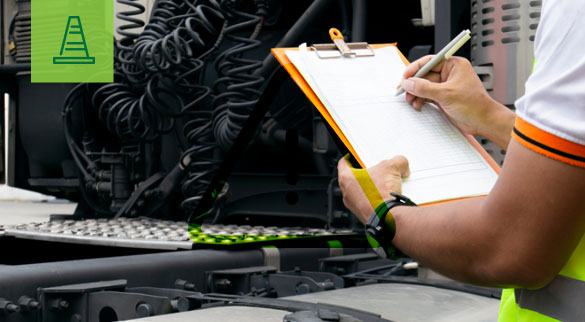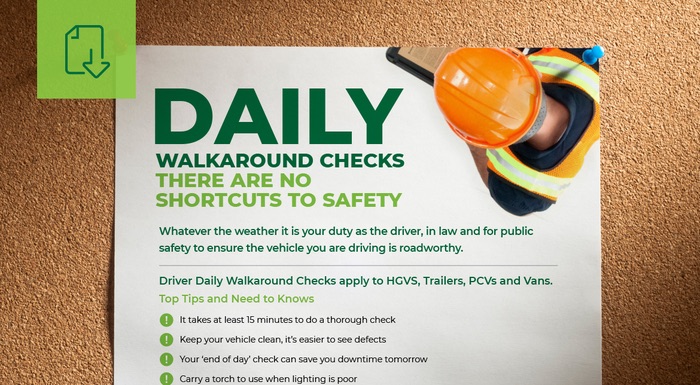Did you know that around 85% of roadside defects found by the DVSA could be avoided if the driver had done a careful defect check?
There are no shortcuts to safety. Operators are legally responsible for ensuring vehicles are maintained and used in a roadworthy condition and it is the driver’s duty, in law and for public safety to ensure the vehicle being driven is roadworthy, whatever the weather.
Drivers need to be carrying out daily walkaround checks before taking any vehicle out on the road.

The Importance of Walk Around Checks
The Driver Daily Walkaround Check applies to HGVS, PCVs and Vans with at least one walkaround check required to be carried out in each 24 hour period.
Should your vehicles be stopped by the DVSA and found to have defects, this will have repercussions on your O Licence and your Operator Compliance Risk Score.
The DVSA uses the Operator Compliance Risk Score (OCRS) system to decide which vehicles should be inspected during roadside checks. As an Operator, you get points when a test or inspection finds a defect or infringement of the laws. The more serious the defect or infringement, the more points you attract and that means your vehicles are likely to be stopped and inspected more often.
If one of your vehicles is found to have a severe defect it will receive an immediate prohibition and the driver could get a fixed penalty. Traffic Commissioners also take action against drivers who fail to complete an adequate walkaround check. This could lead to a driver conduct hearing, which may result in the loss of their vocational driving licence.
Creating Good Practice – How to Record The Results Of Your Daily Defect Checks
The Laws and Guidance make all drivers of all vehicles legally responsible for the condition of the vehicle when in use on the public road. However, it is the Operators responsibility to ensure that they have a maintenance system in place.
The Driver Daily Defect Check must be done before they drive your vehicle on the public road each day wherever the vehicles have been parked – home depot or away. If more than one driver uses the vehicle in a day, the new driver should do their own driver defect check before driving.
A walkaround check must be done on any trailer whether owned by you or another company if your driver is pulling it.
All defects should be reported to the responsible person in the company who ensures drivers do not use/drive a vehicle with a defect until the correct repair is agreed and actioned by your fleet manager.
What you need to know…
Your driver’s daily defect report is a legal document
All the items on a driver daily defect report pad must be marked as checked
Nil defect reports prove that drivers have done a walkaround check and there are no defects
Any defects should be reported to the responsible person and the vehicle not taken out onto the road if the defect affects the vehicle’s roadworthiness until
the defect has been repaired by a qualified person
the repair has been recorded as rectified on the driver daily vehicle defect report
You must keep defect reports for 15 months whether they are on paper or held electronically
Emergency repairs ONLY can be carried out at the roadside. Routine maintenance, including safety inspections and repairs, may not be carried out on the public highway
Remember regular and proper daily defect checks will protect your company from fines and prosecutions. If your vehicles are found to have repeat or severe defects the DVSA will assess your maintenance system.
How Long Should HGV Daily Defect Checks Take?
The guide time to do a proper check is 15 minutes.
All drivers should be trained to carry out the daily defect thoroughly including your company recording and reporting procedures.
Make sure drivers are issued with the following to support their daily defect checks…
Torch, for defects checks carried out where lighting is poor
Tyre tread measure - ensure tyres are checked carefully using a tyre depth measure as well as looking for bulges, cracks and remind them to check wheel nut indicators - the DVSA do
Did you know that a quarter of prohibitions issued to van drivers are for defective tyres?
Vehicle height measuring stick, remind drivers to re-set the in-vehicle cab height indicator prior to setting off
Other specific kit required to complete your company’s vehicle check correctly
Initial training on how to carry out a proper walkaround check should be given at induction with regular reminders.
Request The Road Skills Online Free Safety Awareness Poster
 Get a copy of our downloadable poster to display on your noticeboard, send us an email and we'll get a copy over to you.
Get a copy of our downloadable poster to display on your noticeboard, send us an email and we'll get a copy over to you.
Training You Can Trust
Our DVSA Recognised and CPD Standards Office accredited e-learning delivers consistent, relevant and useful reminders to your drivers in the form of a 15-20 minute pre-made Toolbox Talk each month. Available to access on any device at any time!
When it comes to reminding your drivers of the importance of their daily walkaround checks, we have this covered in our Daily Walkaround Check Toolbox Talk with learning points on Law and Guidance, Driver Responsibility and The Check itself.
To see the full list of Toolbox Talks and see how these regular reminders will help you to improve driver behaviour so that you cut your vehicle costs – click to view or click here to arrange your free demonstration.
Sources| Department of Transport | Guide to Maintaining Roadworthiness from the DVSAhttps://www.gov.uk/government/publications/guide-to-maintaining-roadworthiness
Information and guidance about OCRS https://www.gov.uk/operator-compliance-risk-score


